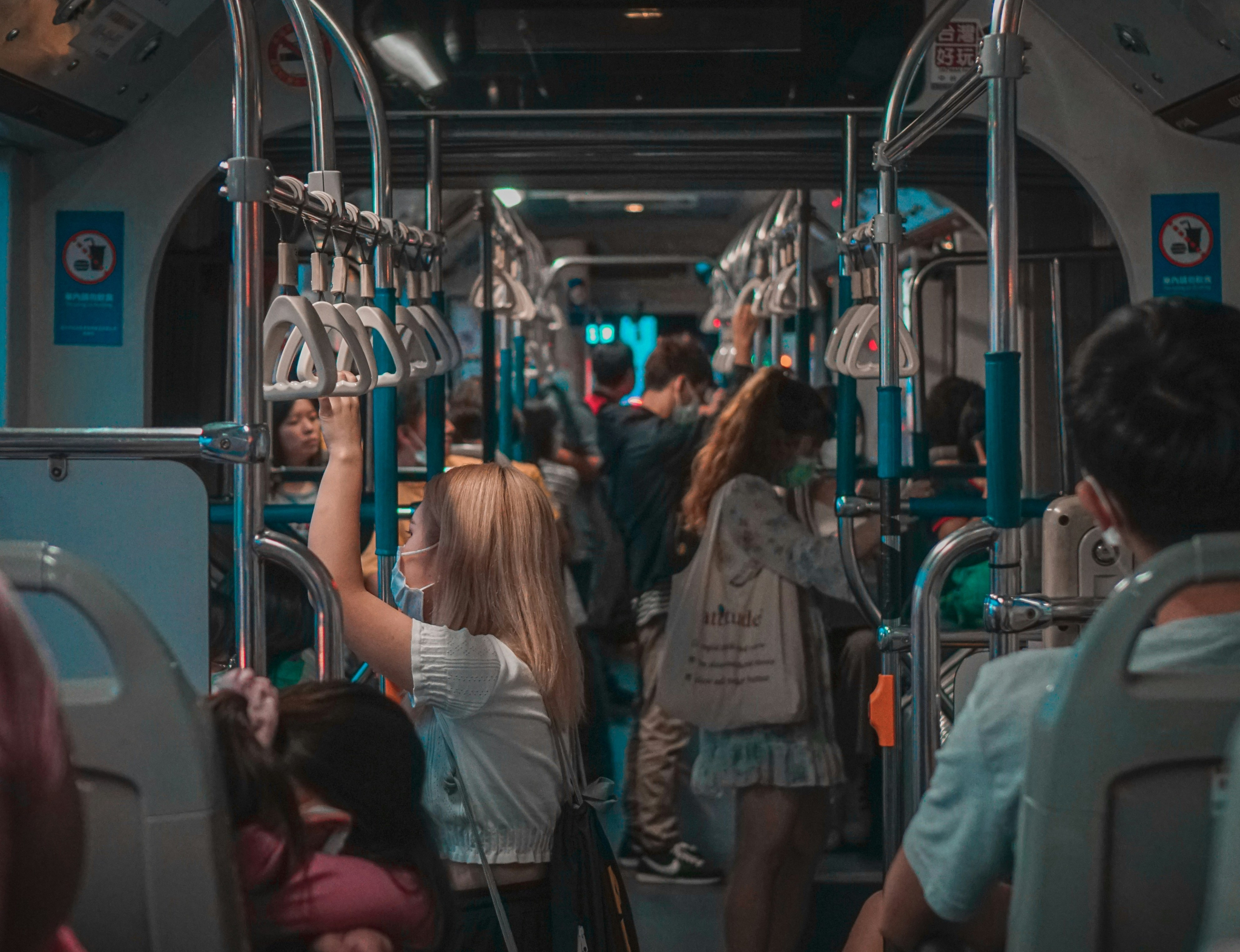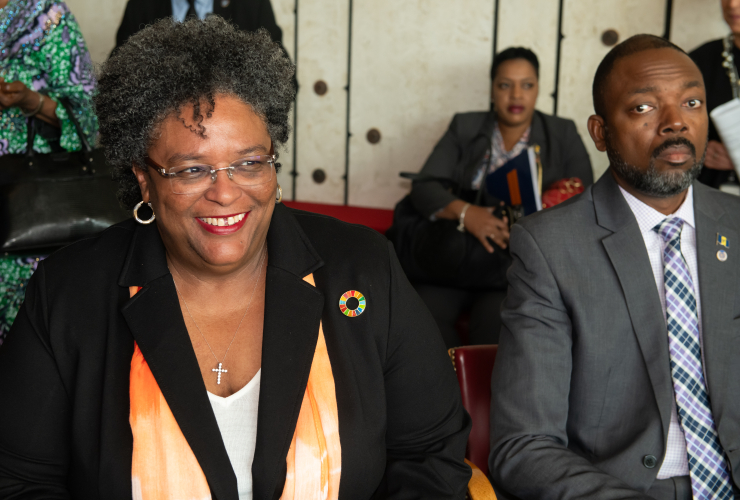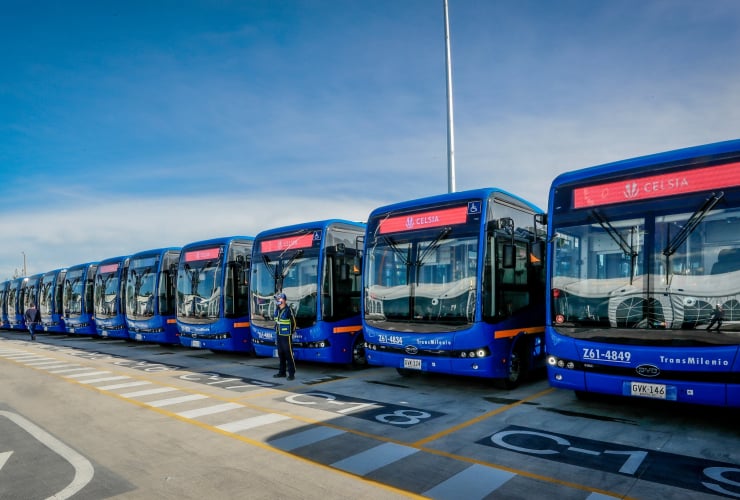Taking the bus in Halifax for Douglas Wetmore often means long wait times, crowded routes and unreliable service.
As part of the transit advocacy group It's More than Buses, Wetmore is pushing for change. A proposed rapid transit bus system, which has been stalled due to a lack of financial support from the province, would help resolve those issues, he explains. Halifax, the second-fastest growing city in the country, relies on municipal buses and ferries for public transport: there are no SkyTrains and no streetcars. At the same time, transit isn’t keeping up with demand: buses are overcrowded and often lag behind schedule.
While Wetmore’s experience is common across Canada, a new report suggests there are measures that could make transit more accessible and reliable and, in turn, significantly reduce planet-warming greenhouse gas emissions. Released Tuesday by Environmental Defence and Équiterre, the study laid out how Canada can double public transit ridership by 2035, reducing GHGs by 65 million tons between 2024 and 2035: the equivalent of the annual emissions from 20 million cars.
That GHG reduction would be significant, explains Nate Wallace, co-author of the report and clean transportation program manager with Environmental Defence. While the federal government has laid out clear targets for EV adoption — all vehicle sales must be zero-emission by 2035 — there aren’t targets to increase public transit ridership.
Wallace says the EV targets are “a game-changer in terms of emissions reductions over the long term,” but that “all of those happen post-2035 and nearly none of it happens by 2030.” Twinning EV targets with clear goals around public transportation presents “a huge opportunity here to address these emissions problems in the near term and not wait for electric cars,” he said.
The report comes as the federal government continues to work on its Permanent Public Transit Fund, which will divvy out $3 billion each year starting in 2026. Wallace said that funding should start this year, and should be for double the amount proposed. The current funding covers capital costs (which are one-time purchases for an electric bus, for example) but Wallace said the same amount should be allotted for operational funding.
The need for operational funding from provinces and the federal government was one of four key actions outlined in the report that, if taken, would allow Canada to hit unprecedented transit use. The others are: encouraging housing density near public transit, requirements for zero-emission buses, and incentives to build dedicated bus lanes. The policy suggestions were supported by modelling by Dunsky Energy + Climate Advisors.
Canada’s National Observer reached out to Infrastructure Canada for comment on federal support for public transit and, specifically, the Permanent Public Transit Fund. The department said details on the fund will be released in "coming months," but that it "generally limits its role" to funding for capital projects.
"Looking ahead to permanent funding, the goal is to establish a program that offers stable, predictable, and reliable funding tailored to diverse local contexts and needs, including in metro regions across the country where the transit demands and funding needs are highest." said the department in an emailed statement.
"By doing so, the program will also help partners make longer-term plans for public transit systems and active transportation networks that advance shared priorities on sustainable mobility, housing supply and affordability, climate action, economic development, and social inclusion."
Operational funding
The need for operational funding is exemplified by the approximately 1,700 buses currently not being used in Canada, said Wallace. While the federal government has provided funds to purchase buses and trains, more needs to be done to ensure they can be staffed and maintained.
Transit needs to be frequent, reliable and affordable for ridership to increase, said Wallace, but when only capital funding is provided to municipalities, all three can suffer. Because municipalities, especially smaller ones, don’t have the money to run the services, they often “choose to pass those operating costs on to riders … as higher fares,” he said.
“And that's working against the goals of what we need to be improving ridership.”
Housing density
According to Statistics Canada, most Canadians use personal vehicles to commute to work. Requiring housing density near public transit routes would help shift that trend, explains Wallace.
At the same time, protections need to be in place for renters. The report notes the phenomenon of transit-oriented displacement, which pushes the people who are most likely to use transit away from major routes.
Wallace said the report highlights the need for “specific anti-displacement strategies,” such as rent control, social and non-market housing requirements and protections for people who already live in areas where transit is being expanded.
“If somebody's existing affordable unit has been redeveloped, they should have their moving expenses covered. They should have a right to return at the same rent where they lived before,” he said.
“Those sorts of things. Because low-income, equity-seeking groups are most likely to take transit and they should be able to afford to live near it.”
Zero-emission buses and bus lanes
The federal government has funded electric buses across the country in recent years. Last year, almost $400 million was put forward in British Columbia for electric buses and chargers and Quebec announced the addition of more than 1,000 electric buses to its fleet at a cost of over $1.8 billion, representing North America’s largest electric bus endeavour. In November, it was announced that Cape Breton in Nova Scotia is set to receive its first electric buses following an investment of over $50 million from the federal, provincial and regional governments.
However, what’s lacking are clear procurement targets, such as what Quebec has in place by requiring a phased approach to fully zero-emission buses starting in 2026.
As more buses get off fossil fuels, federal and provincial governments should also be supporting the creation of bus lanes in cities, which Wallace describes as a “low-hanging fruit.” Bus lanes help with reliability and if transit is going to expand as the report suggests, having dedicated lanes for buses is needed to make service timely, which in turn, will encourage ridership.
Unless the actions in the report are taken, Anne-Catherine Pilon, mobility analyst with Équiterre, said the cycle of sub-par transit causing reduced ridership, which in turn, leads to service cuts and fare increases, will continue.
“We cannot allow a ‘downward spiral’ to erode public transit in Canada just when we need it the most as a clean and affordable climate solution,” said Pilon.
“This report demonstrates that we have an alternative: we can choose to invest in public transit, grow ridership and adapt to new mobility patterns by providing more reliable, convenient and frequent service that works more equitably for everyone.”
Updates and corrections
| Corrections policyThis article has been updated to correct GHG reduction figures and to note that Halifax has ferries as part of its public transportation network.
This article has been updated to include comment from Infrastructure Canada.
The missing link:
While increases in transit
While increases in transit use are desirable and possible, 5 decades of history suggest that we tend to over-estimate the potential attractiveness of transit and under-estimate the appeal of private vehicles. For non-downtown destined trips travel by transit generally involved two the three times the door-to-door travel time that it takes by car. In the wake of Covid public transit is in a difficult position, fighting to maintain pre-Covid ridership and revenue levels. Let's work to get transit back on its feet before we establish unrealistic expectations which will not serve transit in the longer run.
I fundamentally disagree with
I fundamentally disagree with that comment.
The failure of transit is tied directly to NOT providing a frequent transit network, which is one of two tools that adequately counter our deep seated car dependency, which has had seven decades to build out to underpin the far flung, sprawling suburbs and exurbs.
Vancouver increased density downtown and sent fingers of moderately dense development several km into the immediately surrounding older inner city rings. The province of BC also started to build rapid transit and gave a portion of transit authority to the regional government.
The result? Traffic and emissions in the downtown peninsula decreased by double digits while the population doubled. Everone downtown walks or takes transit. More people live in the inner city than ever before but their car use was reduced because walking (a sign of a complete community), biking and transit are so much better.
Vancouver, Toronto and Montreal all have decent transit in their inner cities, but the hub and spoke network pattern requires another layer: circular, inter-suburb networks which are married to a shift in zoning and designing for actual towns instead of single use subdivisions, or multi-family housing near malls with poor transit service. The latter will, without fail, result in clogged freeways and jammed up arterials that do nothing to get people out of their cars or cease the destructive force of overdesigned roads and roaring traffic and pollution to bring down the quality of life and human health in every community they touch.
Vancouver's (the city, not the Metro) overall transit / walk / bike mode share of all daily commutes topped 50% before the pandemic. Today, regional transit ridership has recovered over 90% of its pre-pandemic ridership, which was nearing 500 million boardings a year for a region of three million. The pre-pandemic transit operating cost recovery through the farebox was about half. Name one road that pays half of its operating costs.
The story continues. The demand for high quality transit service is huge when the public actually gets to experience it. Vancouver's Canada Line was controversial from the start for various reasons. But the subway killed a lor of the criticism about costing more than bus service when it exceeded all ridership projections from opening day onward, even though its design was inadequate from the start.
Today the Broadway Subway is over half way completed and the suburban extension of rapid transit to far away Langley us underway.
The lessons learned from nearly 40 years of building out a decent rail network tied to transit-oriented development have been learned well. However, a lot more planning and funding is needed to meet future demand and to reorient Canadian urbanism away from the private car.
A frequent transit network
A frequent transit network includes improved and electrified bus service and surface trams joining up to each hub station and radiating outward from there.
Regional commuter rail is incomplete unless it stimulates genuine tiwn planning at hub stations abd terminus sites. Today, Toronto's Go Trains and Vancouver's West Coast Express offer little more than gigantic parking lots outside the suburban station doors.
We need to open our minds to the solutions practiced in, for example, the Netherlands where regional rail stations are surrounded by actual new towns of medium density that in turn offer a plethora if self sufficient, well-designed communitues.
Instead of popping out of a Go Train station into a cold, windswept parking lot with a bus bay, one should exit into a genuine town square surrounded by stores, cafes and offices with a backdrop of residential, including pupose built affordable rentals. And all of it should be linked together with a fine grain network of pedestrian streets and lanes lined with sidewalk retail punctuated with bus and tram platforms.
Fair comment but you did not
Fair comment but you did not talk about the issue of covid, which is still a pandemic and doing real harm to hundreds of thousands of people. I haven't flown since it started and will likely not until there is evidence it has become endemic and/or we get a sterilizing vaccine. Same applies to mass transit of any type. Not worth the risk for me.
I was mistaken in that you
I was mistaken in that you did briefly touch on pre pandemic ridership vs now. It is telling but 10% is not insignificant and is more reflective of our leaders not providing any...uh, leadership on this issue. If I look at a typical politician, hockey game or restaurant I think they all believe its still 2019.
You are completely right, the
You are completely right, the pandemic is not over. New variants crop up somewhere every few months.
There is severe asthma in my family and we, too, haven't flown for four years. We haven't taken the subway or a bus for over two years. We are religious about masking indoors in public places. We self isolate on the freezing upper car deck on the ferries during our regular sailings to Vancouver Island on necessary elder care missions. Etc.
My reaction was to the comment that we underestimate the attraction to cars compared to transit. That occurs when you don't have decent, let alone adequte transit, to compare to to begin with. Build really good transit infrastructure, make the service frequent and demand will increase proportionately -- when it joins communities that are at least moderately dense enough to support ridership.
My reference to COVID was to how transit ridership has nearly recovered from the pandemic now that the majority of the population is vaccinated
But yes, it is not over, and may always be with us and put the immune compromised at risk. That is why we are happy that we live in a walkable community where 90% of what we need is within a 30-minute commute by walking shoe.
Have not read the report yet,
Have not read the report yet, but I'm glad to see the emphasis on bus lanes and bus rapid transit, and on reducing vehicle kilometers traveled (VKT). The recent Canadian Centre for Policy Alternatives / BC Federation of Labour transit report also focuses on reallocating road space to induce traffic evaporation and reduce VKT. See https://policyalternatives.ca/sites/default/files/uploads/publications/B...
Can we also talk about rural
Can we also talk about rural transit and passenger railways? Yes I know, Canada is a very urban society. But there are people living outside the major centres and a ways north of our southern border.
Canada used to have a passenger railway system. Why can't we have one? Why is there no train schedule that would allow people to travel between Vancouver and Toronto in 24 hours? A train would have to average 185 km/h to do that, far below the 300 km/h speeds that Japanese, Chinese, and European networks run at. Why are there long stretches of railway through populated areas where there is no passenger traffic at all?
Where I live, the province has stepped in to establish a rudimentary bus system along Highway 16, also known as the Highway of Tears. It is being well used, but not conducive to longer distance travel. Surely infrastructure like that should be part of the discussion.
That report came out last
That report came out last week. From the BC Federation of Labour and the Canadian Centre for Policy Alternatives. See https://bcfed.ca/connecting-bc
And then there's Toronto,
And then there's Toronto, where there are frequent outages of elevators, making it so people using wheelchairs or mobility scooters have to "go the long way 'round," sometimes adding hours to the trip time.
It's worse when there's a service disruption, and the "relief" buses or loading platforms will wometimes accommodate wheelchairs, but are impossible to maneuver on a mobility scooter. At other times, they won't work for either.
And then, when you get to your last transfer point? Time on the fare is up, not even having got to the 15-minute destination, let alone being able to squeeze the return trip into a single fare.
Great points. These are just
Great points. These are just some of the items on the long list of average Canadian transit inadequacies that follow the big issues, like inadequate service and the failure of zoning and urban planning to use transit service as a foundational element to build communities around.
Public transit really needs a major injection of not just funding, but forward thinking.






Comments